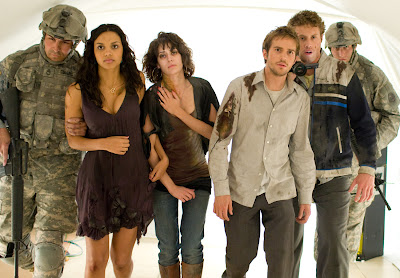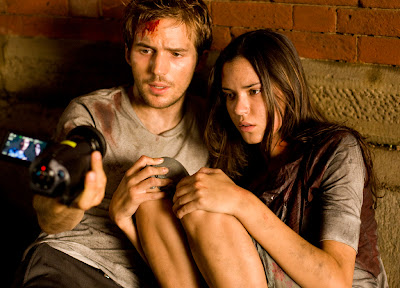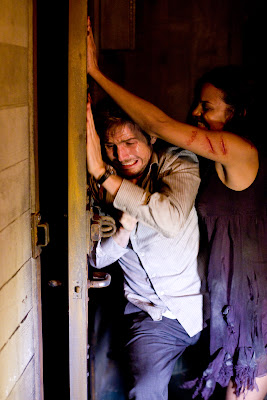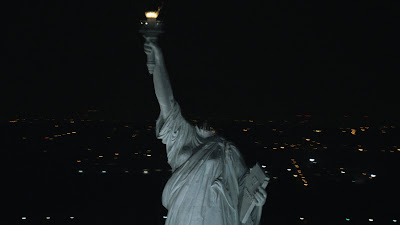 Super-huge, gargantuan, impossible-even-to-grasp-how-big-it-is spoiler alert right here, right now. And consider it in effect until ... well, the remainder. If you haven’t seen Cloverfield, and in fact desire to see it, then you should avert your peepers and click away. The other blogs are quite interesting, I promise you.
Super-huge, gargantuan, impossible-even-to-grasp-how-big-it-is spoiler alert right here, right now. And consider it in effect until ... well, the remainder. If you haven’t seen Cloverfield, and in fact desire to see it, then you should avert your peepers and click away. The other blogs are quite interesting, I promise you. For those still reading, let me announce here that it pains me to send readers away, but with a movie like Cloverfield — with its secretive development, cryptic preview ads and cagey plot details — I’m given no other choice. Movies this secret, with all their unmentionable mystery, could put movie critics out of business.
The idea of keeping elements of a movie hidden probably dates back to Psycho, when Alfred Hitchcock himself would plead with viewers to not spoil the plot. Janet Leigh’s early (and naked) death was a secret because it was startling and unexpected, as was the ultimate revelation that Norman Bates was psychologically deranged. Most secretive movies nowadays try to sell you that same line of logic, that their secrets shouldn’t be spoiled because they’re awesome secrets. Rarely is that really the case, though, since these same movies barely invest any interest into their secrets to begin with. Too often now they’re just marketing ploys.
 Cloverfield is different, though. It’s staying mum, but not because the secrets are jolting or shocking, or even because they’re lame like those in Pirates 3. It’s keeping its mouth shut because it works better when the viewer knows nothing at all walking into it. That is why I’m sending readers away, because a fresh perspective is paramount to everything else.
Cloverfield is different, though. It’s staying mum, but not because the secrets are jolting or shocking, or even because they’re lame like those in Pirates 3. It’s keeping its mouth shut because it works better when the viewer knows nothing at all walking into it. That is why I’m sending readers away, because a fresh perspective is paramount to everything else. Cloverfield is like Signs and The Blair Witch Project crashing into each other at Mach 4. Signs because it takes a major calamity and localizes it onto one reference point on a smaller scale. Blair Witch because it purports to be real footage of real people experiencing a real event. Of course we know it’s not real, but from their shoes it’s mighty authentic.
 We begin with five young adults at a party. An earthquake interrupts the evening, so everyone spills out onto the sidewalk to survey the damage. That’s when Lady Liberty’s head rolls down the street with bite and claw marks marring her pretty green dome. Then, down the street, a large reptilian-like creature crashes through the Chrysler Building rendering it into a fine powder that sweeps down the street in such a way that New Yorkers are all too familiar with. Our five heroes, with their video camera documenting the early carnage, dive into a store and take stock of their limbs.
We begin with five young adults at a party. An earthquake interrupts the evening, so everyone spills out onto the sidewalk to survey the damage. That’s when Lady Liberty’s head rolls down the street with bite and claw marks marring her pretty green dome. Then, down the street, a large reptilian-like creature crashes through the Chrysler Building rendering it into a fine powder that sweeps down the street in such a way that New Yorkers are all too familiar with. Our five heroes, with their video camera documenting the early carnage, dive into a store and take stock of their limbs. From there on they document their journey through the city, first to escape on the Brooklyn Bridge and then to rescue a girl trapped on a roof somewhere in Midtown Manhattan. Of course these tasks are not easy, because, if they didn’t notice, there’s a monster the size of Vermont stomping through Madison Avenue. And he makes Godzilla look like a member of the Wiggles — kid’s stuff.
 The quintet — soon-to-be quartet — dodge falling debris, looters, fleeing rats and destructible architecture to eventually take cover in the streets as the military sends bullets, mortars, rockets and salvos of hot lead into the creature’s side, apparently to no effect. “Whatever it is, it’s winning,” a soldier tells the group, who work out a deal to get access to Midtown to save their friend on the 59th Floor of a building pushed Pisa-like into its neighboring skyscraper by the monkey/lizard/whale monster. They’re told to be clear of the city by 6 a.m., when a siren will signal an ominous and unavoidable event.
The quintet — soon-to-be quartet — dodge falling debris, looters, fleeing rats and destructible architecture to eventually take cover in the streets as the military sends bullets, mortars, rockets and salvos of hot lead into the creature’s side, apparently to no effect. “Whatever it is, it’s winning,” a soldier tells the group, who work out a deal to get access to Midtown to save their friend on the 59th Floor of a building pushed Pisa-like into its neighboring skyscraper by the monkey/lizard/whale monster. They’re told to be clear of the city by 6 a.m., when a siren will signal an ominous and unavoidable event. See, now I’ve gone and given away too much, spoiler alert or not. That’s all the plot you get.
Cloverfield, part human drama and part horror flick, is a fascinating picture that gets very inventive with its camera gimmick. By making a video camera the film’s point-of-view, it allows us to experience the monster the way most people now experience the Internet — from another person’s perspective. (The video is marked “Department of Defense” but something tells me in the film’s world it’s already on YouTube.) Although this trick should limit the directions of the plot, the movie is still able to employ romance, humor, suspense and even flashbacks (in the form of undeleted video) to its arsenal of tricks. These are difficult tasks given Cloverfield’s methods. To squeeze a sense of humor out of this is very complicated; as it turns out, people are naturally funny, sometimes even when monsters destroy their city.
One drawback to the handheld-style point-of-view is that some people will feel a little ill. Some might heave into their popcorn. The shaky camera is not kind on weak stomachs, that’s for sure.
 As much as I liked Cloverfield, though, it wasn’t wrapped up as neat as I would have liked. It responds to the monster’s actions in strange ways during the final 10 minutes. And the characters make questionable decisions in the closing moments after 80 minutes worth of (somewhat) wise choices. I also found some of the torturous, end-of-the-line dialogue a little unsettling. At times it felt almost too personal and the camera lingered on it so, long that it felt obtrusive. Maybe the acting - by a bunch of unknowns to boot — was just that effective. Maybe being a voyeur is supposed to be uncomfortable. Whatever it was, it worked, and in a big way.
As much as I liked Cloverfield, though, it wasn’t wrapped up as neat as I would have liked. It responds to the monster’s actions in strange ways during the final 10 minutes. And the characters make questionable decisions in the closing moments after 80 minutes worth of (somewhat) wise choices. I also found some of the torturous, end-of-the-line dialogue a little unsettling. At times it felt almost too personal and the camera lingered on it so, long that it felt obtrusive. Maybe the acting - by a bunch of unknowns to boot — was just that effective. Maybe being a voyeur is supposed to be uncomfortable. Whatever it was, it worked, and in a big way. Oh, by the way, spoiler alert over.
No comments:
Post a Comment